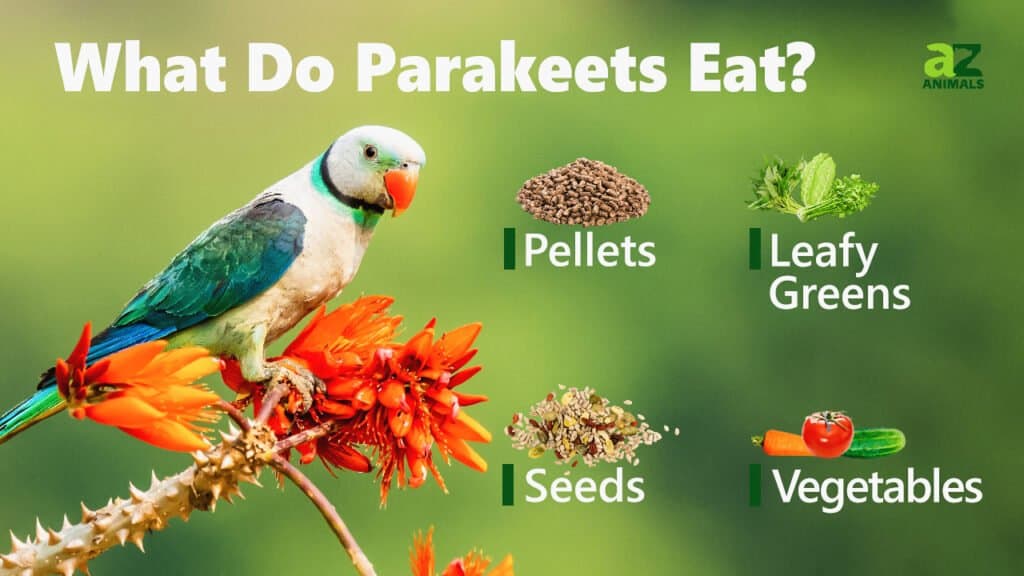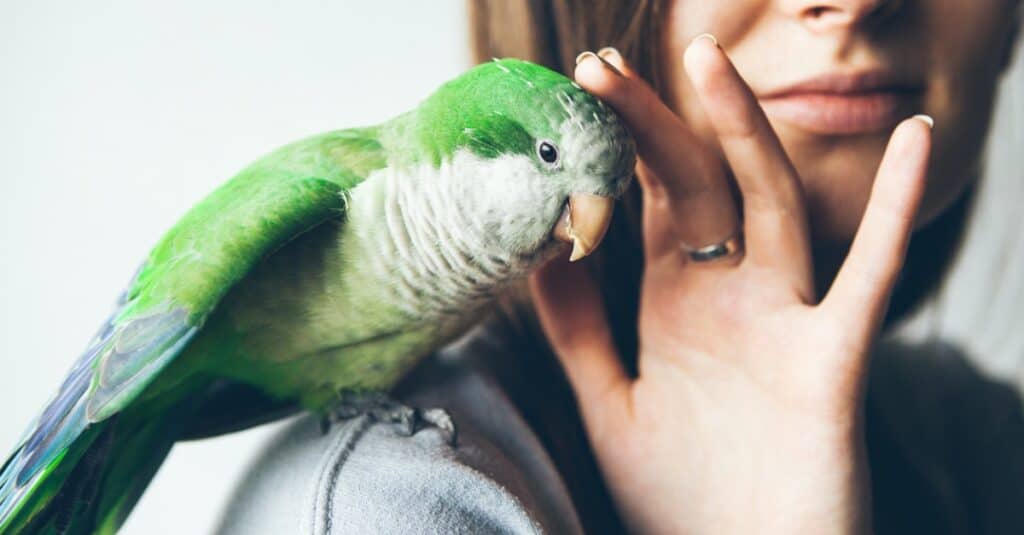The parakeet, often known as the budgerigar (or budge), is a type of long-tailed parrot that belongs to the true parrot family. The name “parakeet,” comes from the French word “perroquet,” which means “parrot.”
Parakeets have been found to live in a variety of climates and conditions which include forests, meadows, and other water-rich areas. Thanks to their adorable appearance, intelligence, and talkative nature, parakeets have become one of the most popular pets, specifically in the United States.
As such a popular pet choice, you may be wondering what exactly do parakeets eat? We’ll explore the parakeet diet and the best food options for them when kept as a pet.
What Do Parakeets Eat?

Parakeets eat seeds, fruits, and vegetables. Parakeets are mostly granivores that consume seeds and grasses in the wild. Many parakeet species will forage forest and savannah grounds in order to find food, which explains why many of them are ground feeders. They even happen to consume more seeding grasses than larger parrots.
In the wild, parakeets are also known to eat tree seeds, buds, and bark.
Here is a list of the most common foods that parakeets will eat:
- Seeds (millet seeds, sunflower seeds, safflower seeds, and canary seed)
- Nuts (acorns, hazelnuts, peanuts, pistachio, walnuts, and pecans)
- Fruits (apples, bananas, coconut, melon, blackberries, watermelon, and pineapple)
- Vegetables (bok choy, broccoli stems, cabbage, carrots, celery, green lettuce, and spinach)
- Grains (buckwheat, barley, oats, rye, and quinoa)
- Flowers (African violets, carnations, chrysanthemum, daisies, magnolias, marigold, petunias, roses, sunflowers, and violets)
In the wild, parakeets eat a wide variety of foods. Flowers, seeds, fruits, and leafy green vegetables are all favorites of parakeets that are not domesticated. However, seeds will make up the majority of their diet.
How Much Do Parakeets Need to Eat?

Wild parakeets are excellent foragers.
©Randy Bjorklund/Shutterstock.com
In the wild, parakeets fend for themselves and, as mentioned, will eat a broad variety of foods to keep up their health. A wild parakeets’ diet will mainly consist of seeds and they will eat as much as they need to keep up their health.
However, while wild parakeets are able to forage until they know they are full, it is important to remember that parakeets in captivity do not have the same ability to do this.
When kept in captivity, it is important to feed them specific amounts of food to keep up their health. Smaller adult parakeets must be fed around .5 to 1 teaspoon of seeds and pellets while larger birds should be fed around 1 to 1.5 teaspoons of seeds and pellets.
What Do Parakeets Eat in the Spring & Summer
Parakeets eat whatever is available to them throughout certain times of the year. So, throughout the fall and winter months, they consume seeds more than anything else, and during the spring and summer months, they eat plants, fruits, and vegetables.
What a parakeet eats is determined by where it lives. Some parakeets live primarily on seeds, while others eat fruits and vegetables for the majority of their meals. Parakeets are indigenous to Australia and other desert and tropical climates. Because some live in ideal tropical climates, they are able to eat such a diverse diet.
What Are the Parakeets’ Predators?
Despite being members of the bird family, other large birds can feed on other birds such as parakeets. Large birds, such as eagle and falcon species, are the ones most likely to prey on the parakeet. Parakeets can also become victims to feral cats and rodents who will occasionally attack parakeet nests for eggs or kill the birds themselves. Snakes can also present themselves as a problem, especially for birds living in the rainforest.
What To Feed Parakeets As a Pet

Parakeets’ charming nature makes them a popular pet choice.
©iStock.com/insonnia
As such fun and intelligent birds, parakeets make a great pet. Many people enjoy having a parakeet, particularly because they can learn to speak. Another great reason people love them as a pet is that they can live for up to 29 years in captivity.
When it comes to feeding your pet parakeet, it’s important to know what they eat in the wild. Parakeets should eat a diet similar to what they would eat in the wild as much as possible. Because seeds comprise around 90% of their food, parakeets should always have them available in their feeder.
Leafy greens are another great food option that they can enjoy on a daily basis.
However, fruits should be kept to once a week as they are high in sugar. There are also several foods that you can introduce as occasional treats for parakeets. These include beans, boiled egg, pasta, coconut, and chilies.
What Can’t Parakeets Eat?
If you are interested in keeping a parakeet as a pet, it’s important to know what foods they can’t eat. When it comes to the health of your parakeet, there are several foods that should be avoided. While we know that chocolate can be incredibly toxic to dogs, it is also highly toxic for parakeets to consume.
You should also never be feeding your parakeet coffee, tea, sugar-free candy, fried or salty foods, dairy products, and alcohol. There are also several vegetables and fruits that can be harmful to these birds. Avocados, onion, and garlic should all be avoided. Other foods to avoid include bread, mushrooms, tomatoes, any fruit seeds or pits, and crackers.
While fruit seeds are to be avoided, as they can be a choking hazard, you may still feed your parakeets cherries, apricots, and a variety of pitted fruit as long as you first remove the pit or seeds.
The photo featured at the top of this post is © Foto 4440/Shutterstock.com
Thank you for reading! Have some feedback for us? Contact the AZ Animals editorial team.







